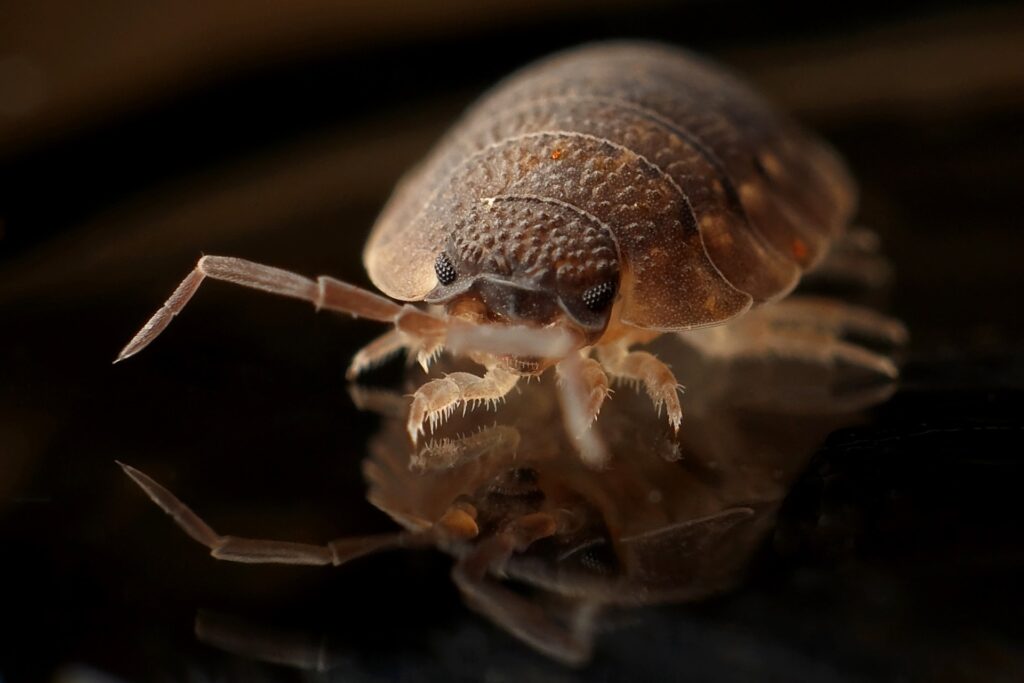What are Bed Bugs?
Bed bugs are parasites that feed on the blood of mammals and belong to the family Cimicidae.
Bed bugs are known for their ability to hide in cracks and crevices, especially in and around mattresses, which gives them their eponymous name as “bed bugs.”

How to Identify Bed Bugs
Adult bed bugs have wingless, oval-shaped bodies that are flattened from top to bottom. They have six legs and resemble the size and shape of an apple seed.
Before feeding, bed bugs are a reddish-brown color. After feeding, they turn purplish-red, and their bodies swell and elongate in a balloon-like manner.
Young bed bugs (nymphs) are smaller than adults but are exactly similar in appearance–though difficult to detect.
Signs of Bed Bugs
While tiny in size, bed bugs tend to make their presence noticeable due to their intrusive habits, which include:
- Bite marks on the skin that swell or are irritated.
- Blood stains on the sheets from said bitemarks.
- Fecal droppings on sheets and bedding materials.
- Musty odors they exude from their bodies.
- Exoskeletons they shed and leave behind.
Bed bugs can also be identified by the naked eye, though this may require careful inspection of infested materials, especially for nymphs.
Understanding Bed Bug Life Cycles
Bed bugs follow the normal stages of development as every pest, from egg to adult. However, bed bugs can live for up to a year and reproduce multiple times, depending on the hospitality of their environment. For this reason, dealing with bed bugs immediately is critical to reducing population sizes.
Are Bed Bugs Dangerous?
Bed bugs are not thought of as dangerous pests, but they do cause problems and concerns for people:
- People who are allergic to bed bug saliva can develop an itchy rash.
- Rashes that bed bugs cause can become infected and require medical attention.
- Bed bug infestations can cause stress, embarrassment, and sleepless nights.
Nevertheless, bed bugs are invasive pests, and their presence should be eliminated from any home or building as quickly as possible. If a bed bug infestation is allowed to thrive, these pests will eventually move throughout your home and become even more difficult and time-consuming to eliminate.
Why Do I Have a Bed Bug Problem?
Bed bugs live and hide out wherever there are people. Therefore, bed bug populations can be found in virtually any public place. For example, bed bugs are commonly found around:
- Hotels and motels
- Second-hand furniture
- Consignment stores
- Public transportation systems, such as buses and subways
For this reason, inspecting materials from any of these places, including luggage or second-hand goods, will help you spot potential problems before they arise.
How to Inspect for Bed Bugs: Where Do Bed Bugs Hide?
One particularly difficult aspect of dealing with a bed bug infestation is controlling the spread of said bugs throughout your home. After finding their way inside a home, bed bugs are known to hide in:
- Tight cracks and crevices
- Wooden head and footboards
- Dressers
- Walls
- Floorboards and carpeting
- Upholstered furniture
- Wooden furniture
- Cabinets
- Closets
- Electronic outlets
- Wall voids
- Behind wooden molding
A bed bug infestation typically takes root in the areas of a home where people sleep. However, if the infestation continues and grows, they will move throughout the entire home–though they will stay near where humans lay for food.
Bed Bug Prevention Tips
Preventing problems with bed bugs can be tricky, but there are several things you can do to protect your home and family from them:
- Inspect hotel rooms (or rooms where you will stay overnight) for bed bugs before bringing luggage and other belongings into it.
- After returning home from a trip, wash and dry all clothing from your trip in a high-heat setting.
- Keep personal items up off the floor in public settings.
- Inspect any used furniture, mattresses, and box springs before you bring them home.
How Do I Get Rid of Bed Bugs?
Eliminating bed bugs from your home can be tricky. Here are some steps you can take to attempt to eliminate a bed bug infestation DIY.
- Identify the extent of the infestation and isolate any infested areas. This means sealing off any gaps and cracks and keeping bed bugs confined to certain rooms.
- Clean up any clutter, vacuum your floors and upholstery, and steam all carpets, mattresses, and box springs with a steamer.
- Wash and dry all infested clothing and sheets on a high-heat setting.
- Apply a pesticide to any remaining areas, such as behind molding, wall cavities, or wall outlets.
- Use a bed bug cover on all bedding and furniture until you are ensured the bed bugs are gone.
While it’s possible to fend off bed bugs on your own, you will often save time and money by calling a professional.
At Pest Czar, our local and experienced professionals can provide the comprehensive services needed to find and get rid of bed bugs living in your home. We offer inspection services and treatment for fast and efficient bed bug control in Baltimore. We also offer residential home protection plans that are GreenPro-certified and guaranteed to keep bed bugs away. For exceptional, eco-friendly bed bug control services in the Baltimore Metro area of Maryland, call Pest Czar!
Related Resources
5 Ways to Get Rid of a Bed Bug Infestation
11 Ways to Keep Bed Bugs Out of Your Home
How To Identify And Get Rid Of A Bed Bug Infestation In Your Baltimore Home
Three Signs Of Bed Bugs To Watch For Around Your Baltimore Home
Get Started Today with a Free Quote
Complete the form below to schedule your no obligation inspection.
- Zero-Contact Service
- Same-Day Inspection/Service
- Real-Time Notifications

Customer Reviews
“Joe is knowledgeable and professional. Thanks for the great service!”
Adam | Reisterstown, MD | Read Reviews


